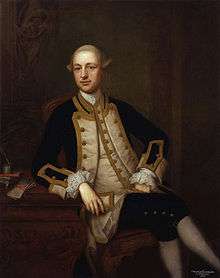Maurice Suckling
| Maurice Suckling | |
|---|---|
 Maurice Suckling, by Thomas Bardwell, 1764 | |
| Born |
4 May 1726[1] Barsham, Suffolk |
| Died | July 1778 (aged 52)[2] |
| Allegiance |
|
| Service/branch |
|
| Rank | Captain |
| Battles/wars | Seven Years' War |
Captain Maurice Suckling (4 May 1726 – 14 July 1778) was a Royal Navy officer who was instrumental in the training of his nephew, Horatio Nelson.
Early life
Maurice Suckling was born on 4 May 1726 at the rectory house in Barsham, Suffolk. He was the second of four children to the Reverend Maurice Suckling of Barsham, and Anne Suckling, a niece of Robert Walpole.[3] Reverend Suckling died in 1730 and the family relocated to Beccles. At the age of thirteen Maurice left home for Sheerness where on 25 November 1739 he enlisted as an ordinary seaman aboard the elderly 54-gun warship Newcastle.[3]
Seven Years War
Suckling was the commander of Dreadnought in action in the Battle of Cap-Français off Saint-Domingue on 21 October 1757.[4]
It was Suckling who was responsible for Nelson's early training.[4] Young Nelson was entered on the books of the newly commissioned Raisonnable, commanded by Suckling, and joined the crew several months later, in early 1771.[4] Suckling was transferred to the Nore guardship and arranged for his nephew to sail to the West Indies in a Hibbert, Purrier and Horton merchantman, the Mary Ann captained by John Rathbone,[5] gaining experience of seamanship and life at sea (he sailed from Medway, Kent, on 25 July 1771 sailing to Jamaica and Tobago, returning to Plymouth on 7 July 1772). Suckling also used his influence to have Nelson appointed to the Carcass for a 1773 expedition in search of the Northwest Passage. Suckling became Comptroller of the Navy[4] in 1775 and was able to speed Nelson's career. He continued to use his influence on Nelson's behalf until his death in 1778.
Suckling had a brief career in Parliament, presumably with Admiralty support. He was returned unopposed to represent Portsmouth on 18 May 1776, replacing Sir Edward Hawke who had been created Baron Hawke and called to the House of Lords, but there is no record of Suckling having voted or spoken.[6]
Family
Captain Maurice Suckling's sister was Catherine Suckling (1725–95), wife of Reverend Edmund Nelson. Maurice and Catherine were the great-great grandchildren of the poet Sir John Suckling, and grandnephew and grandniece of the first British Prime Minister Robert Walpole.
Suckling's nephew, Lieutenant Maurice William Suckling (1761–1820), also served with his uncle.
References
- ↑ Laughton, L.G.C.; Anderson, R.C.; Perrin, W.G.; Society for Nautical Research (London, England) (2002). The Mariner's Mirror. 88. Society for Nautical Research. ISSN 0025-3359. Retrieved 2014-12-10.
- ↑ Mahan, A.T. (2011). The Life of Nelson: The Embodiment of the Sea Power of Great Britain. 1. Cambridge University Press. p. 21. ISBN 9781108026048. Retrieved 2014-12-10.
- 1 2 Syrett 2013, p. 33
- 1 2 3 4 "National Maritime Museum | Captain Maurice Suckling". nmm.ac.uk. Retrieved 2014-12-10.
- ↑ "Joining the Royal Navy". Nelson, Trafalgar and those who served. National Archives. Retrieved 28 July 2015.
- ↑ "Suckling, Maurice (1726-78).". History of Parliament. Retrieved 15 August 2016.
Bibliography
- Syrett, David (22 March 2013). "Nelson's Uncle: Captain Maurice Suckling". The Mariner's Mirror. UK: Society for Nautical Research. 88 (1). Retrieved 21 December 2014.
| Parliament of Great Britain | ||
|---|---|---|
| Preceded by Sir Edward Hawke Peter Taylor |
Member of Parliament for Portsmouth 1776–1778 With: Peter Taylor 1776-1777 Sir William Gordon 1777-1778 |
Succeeded by Hon. Robert Monckton Sir William Gordon |
| Military offices | ||
| Preceded by Sir Hugh Palliser |
Comptroller of the Navy 1775–1778 |
Succeeded by Lord Barham |